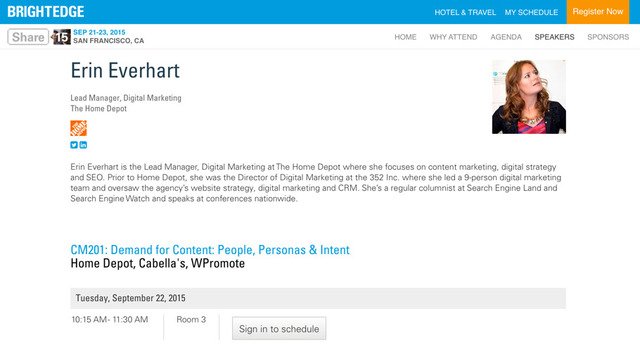Content Performance Marketing, the sharing of insights and the elevation of personal and professional performance, is central to the Share15 theme this year. Over 60 global brand speakers and 1000 digital, content, and search marketers come together on September 21 – 23 in the heart of San Francisco. As the search, content and digital marketing ecosystems continue to evolve in synergy Erin Everhart, Lead Manager for Digital Marketing - SEO, from Home Depot states:
“Because we consume content in different mediums and because we use so many different media types based on our time of day, device, search query, and maybe even our mood, companies can’t exist on only one channel.”
About Erin Everhart and Home Depot
 Erin is speaking on the content marketing track at Share15 on the Demand for Content: People, Personas & Intent session alongside Michael Mothner, CEO of Wpromote and Jesse Farley from Cabela’s. Erin leads the content marketing team in the digital marketing and SEO department at Home Depot. Her primary focus is content optimization and marketing; better leveraging different channels for both onsite and offsite initiatives to increase .com traffic and demand.
Erin is speaking on the content marketing track at Share15 on the Demand for Content: People, Personas & Intent session alongside Michael Mothner, CEO of Wpromote and Jesse Farley from Cabela’s. Erin leads the content marketing team in the digital marketing and SEO department at Home Depot. Her primary focus is content optimization and marketing; better leveraging different channels for both onsite and offsite initiatives to increase .com traffic and demand.
Below, Erin shares further insights into how the search landscape has evolved and how the shift from keyword to page performance strategies signify the marriage of search and content performance marketing.
SEO is a different ballgame
BrightEdge (BE): In your opinion, just how much has SEO evolved in recent years?
Erin Everhart (EE): It’s curious, actually, and something I’ve been thinking about more and more as search continues to evolve. You can ask almost anyone and they’ll agree that SEO is a totally different ballgame, if not a completely different sport, today than what it was 10, even 5 years ago. The tactics used today are completely different. I think a large part of that change is attributed to Google. It is becoming much more sophisticated at being able to spot the sites that aim to manipulate their algorithm. Search Engine Watch did a really great write-up of the history of Matt Cutts’ (and by transitive property, Google’s) stance on SEO. Points that were made in the early 2000s are the same things being said now, albeit replacing PageRank with Domain Authority. For example:
- 2002 - “ranking individual pages based on the number and the importance of the pages linked to them.”
- 2002 – “stay away from hidden text, hidden links, cloaking, sneaky redirects, lots of duplicate content on different domains and doorway pages.”
- 2003 – He was one of the inventors on Google’s patent that said it adjusted rankings based on how often a page is clicked, if the page had newer content, traffic and link weight.
- 2004 – “Thematic incoming links from authority sites carry more weight than on-page optimization.”
The point being that maybe SEO hasn’t really changed all that much in the past 10 years; Google has just gotten better at spotting the spam, forcing the old black hat SEOs to legitimize their tactics.
Page performance strategies are a new priority
BE: How important is page performance compared to keyword strategies in a Secure Search World?
EE: Just using keyword strategies doesn’t work too well because they’re often far too granular and really only encompass a small sliver of the landscape. Just think about the number of keywords out there and then the number of keyword variations out there that people use. One keyword is not indicative into how all of your users come to your site; it’s a fraction of a fraction of your potential customer base. Page performance strategies allow you to have a good viewpoint of both how people are getting to your site and what they’re doing once they get there, which ultimately you need both if you’re going to make a successful website. Just as you want your keyword to match your pages content, you also need to match up the intent of both the query and the page itself. Think - What’s the purpose? Transactional? Informational? Inspiration? Ranking a transactional page for an informational keyword is only going to bring you high bounce rates and annoyed users, who have already exited your site and found what they’re looking for on one of your competitors.
Content and SEO – “one cohesive bubble”
BE: What is your viewpoint and subsequent approach to leveraging SEO and content together?
EE: You have to view content and SEO in one cohesive bubble. Search can, and should, be helping drive what content you produce; content can, and should, be one of the key entry points for your users that helps move them through the buying journey. Content comes from a lot of different places, and there’s probably not one person in your organization who owns all the content. So, not only do you need to have writers embedded directly on your SEO team and everyone on your SEO team should have a content-first mentality, but you (as the SEO) need to ingrain yourself within the other teams who produce content. For example, social media, PR, email and web teams. Those will be some of the best relationships you can manage, making sure they understand how their actions impact SEO but more importantly, how you (as the SEO) can make their job easier and help them achieve their KPIs more efficiently.
Converged media – multi-channel marking versus omni-channel strategy
BE: What role does digital play in the convergence of media, search and content strategies?
EE: I don’t really view it as a convergence because I don’t think digital marketing can or could have ever existed without some form of content. They’re not interchangeable terms — content is used in digital marketing; digital marketing distributes the content — but there wasn’t a time when we marketed without content. That’s all marketing, not just digital. Content consumption has grown massively just by the sheer number of ways we, as users, can access it, but that content has to be distributed somehow. Because we consume content in different mediums and because we use so many different media types based on our time of day, device, search query, and maybe even our mood, companies can’t exist on only one channel. However, it’s not enough to just be active across all channels; that is a multi-channel marketing strategy. You have to make sure your messaging is aligned across all channels, and more importantly, they’re all working together to achieve the common business goal; that’s an omni-channel strategy.
“If multi-channel is each medium having its own swim line, omni-channel is one giant pool party."
How to take advantage of the Share15 networking opportunity
BE: What advice can you give share attendees in order for them to make the most out of their Share15 experience?
EE: Take advantage of every networking opportunity given to you at Share15, even if that’s coffee or a quick lunch. At Share15, you never know whom you’re going to meet and having that strong network of leading industry peers to bounce ideas off of is critical in this industry.
Join Erin and your digital marketing peers at Share15 and become part of the industry leading digital marketing community run by digital marketers for digital marketers.
Early bird pricing closes on July 31, so we would strongly advise you to sign up and take advantage of this rate.
Capacity is limited. Register here.


